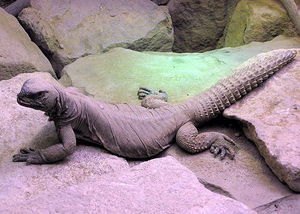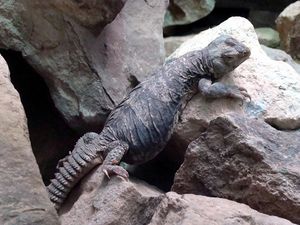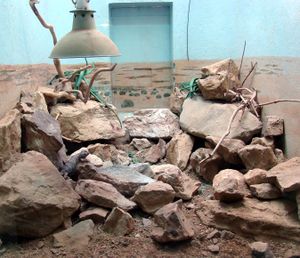Difference between revisions of "Spiny-tailed Lizard"
| Line 22: | Line 22: | ||
==Enclosure== | ==Enclosure== | ||
| − | [[Image:Spiny_tailed_lizard_enclosure.jpg|300px|thumb|right|Spiny-tailed lizard (''Uromastyx flavifasciata'') enclosure at ZSL London Zoo | + | [[Image:Spiny_tailed_lizard_enclosure.jpg|300px|thumb|right|'''Spiny-tailed lizard (''Uromastyx flavifasciata'') enclosure at ZSL London Zoo''']] |
Uromastyx require a desert environment with a hot and dry atmosphere. | Uromastyx require a desert environment with a hot and dry atmosphere. | ||
Revision as of 21:37, 24 November 2010
| This article has been peer reviewed but is awaiting expert review. If you would like to help with this, please see more information about expert reviewing. |
Scientific name: Uromastyx sp., approximately 13 species.
Other common names: Uromastyx, mastigure, dab lizards.
Description
Spiny-tailed lizards are diurnal and terrestrial. Adults reach 60cm (up to 75cm some spp.). Uromastyx are large, flattened, heavy-bodied lizards. They have a club-like spiny tail with which they readily defend themselves. The head, blunt-snouted, looks rather like that of a tortoise. They are generally brown/olive in colour but coloration can be variable between and within species. Uromastyx may also change colour according to their body temperature; they emerge from their burrows with a dark colouring that becomes light as they warm up. Such warming also produces bright species-specific lateral coloration from pale green to intense orange. Uromastyx aegypticus and Uromastyx hardwicki are usually dark to light brown. Uromastyx acanthinurus can be yellow, green, bright orange or a combination of these colours. Uromastyx ornatus are sexually dimorphic with adult males being green or blue green with blotches of yellows and oranges. Females have more subtle yellows, browns, and some orange.
Adult males of these species usually have larger femoral pores, larger heads with larger jowls and a larger cloacal opening. They are easier to distinguish in the spring when hemipenal swellings may be evident in the males. Uromastyx ornatus are the easiest to sex due to males having enlarged femoral pores and being more colourful than females. Uromastyx acanthinurus can be extremely difficult to sex.
Range
North Africa and the Middle East, also Algeria to Turkey. Spiny-tailed lizards are adapted to arid regions (desert dwellers) and spend the heat of the day at the bottom of deep cool burrows.
Diet
Spiny-tailed lizards are omnivorous. Since there is no data about the specific nutritional requirements of this genus a large variety of food items should be offered although the foundation should be vegetable matter. Young animals more readily accept insects such as wax worms and crickets which should be offered three or four times per week. Adults can be offered the same and also king mealworms. The following vegetables should be offered; kale, collard greens, mustard greens, sweet potatoes, carrots, peas, corn, and green peas. In addition, dandelion greens, alfalfa, grass, strawberries and flowers can be added to the diet. Beans such as split peas, lentils, navy beans, and other should also be provided. Some of these beans can be sprouted prior to feeding. Supplementation is necessary.
Enclosure
Uromastyx require a desert environment with a hot and dry atmosphere.
Cages should be spacious and can consist of glass aquariums, metal stock tanks, or wooden boxes. Sand, dirt and newspaper are often used for substrate. Rocks or other objects should be placed in the cage to allow climbing and basking sites. There should be suitable provision for cooling off in the form of wooden hide boxes and/or drainpipes. Deep layers of substrate for burrowing would be ideal but is often impractical. Good ventilation is necessary.
A variety of outdoor caging types can be constructed for warmer climates including a simple sheet metal ring sunk 30cm in the ground and standing 60cm above ground. The height is adjusted depending upon the size of the animals. Outdoor cages should be secured with a wire top to prevent predators from entering.
Temperature
These lizards are adapted to hot desert conditions and require temperatures of over 35ºC to feed. The cage should have a daytime hot basking spot where the temperature exceeds 40ºC, however the lizard must be able to retreat to areas with a temperature of 32-34ºC. Incandescent spotlights can provide hot basking spots. The wattage selected depends upon the size of the cage. Thermometers should be placed at both ends of the cage and monitored to ensure a proper temperature gradient. Under tank heaters can be used to supplement heat, however these species regulate their body temperature by basking in the sun. Spotlights more accurately approximate the way diurnal lizards obtain their heat naturally.
Night-time temperatures should be less that the daytime highs. Temperatures should be allowed to drop to 20ºC.
Breeding
Mating March-April. Oviposition is in April-June.
Literature Search
Use these links to find recent scientific publications via CAB Abstracts (log in required unless accessing from a subscribing organisation).
Spiny-tailed Lizard (Uromastyx spp.) publications



